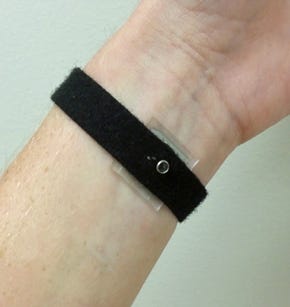Look Ma, No Gel: Dry Electrodes Could Enable Longterm EKG
January 20, 2015
Researchers from North Carolina State University have developed a potentially transformative technology that can seamlessly track electrophysiological signals, such as electrocardiography (EKG) and electromyography (EMG) signals.
|
The silver nanowire sensors conform to a patient's skin, creating close contact, according to North Carolina State. Image credit: Yong Zhu. |
The new sensor could potentially be used for long-term monitoring, and is just as accurate as the "wet electrode" sensors regularly used in hospitals, according to a news release from the university. The benefits of long-term tracking of electrophysiological signals could be vast, as it would allow doctors to constantly monitor any changes in a patient's signals in real time.
In an age where transformative technology continues to shrink, wearable devices are becoming more and more ubiquitous. Researchers continue to look for new wearable technologies that are both less invasive, and extremely efficient when it comes to monitoring personal health.
Traditional electrophysiological sensors used in EKG machines utilize wet electrodes that rely on an electrolytic gel between the sensor and the patient's skin, all in an effort to improve the sensor's ability to pick up the body's electrical signals. Unfortunately, when the gel dries it makes the sensor less accurate, negating the possibility of any long-term monitoring.
This new nanowire sensor is a "dry" electrode that doesn't depend on a gel layer, while still producing accurate signal readings. Yong Zhu, an associate professor of mechanical and aerospace engineering at the university, and senior author of a paper describing the work, spoke to university news about the technology and its design.
"People have developed other dry electrodes in the past few years, and some have demonstrated the potential to rival the wet electrodes, but our new electrode has better signal quality than most -- if not all -- of the existing dry electrodes," Zhu said. "In addition, our electrode is mechanically robust, because the nanowires are inlaid in polymer."
Zhu developed the sensor from his previous work, which involved creating highly conductive and elastic conductors made from silver nanowires, consisting of one layer of nanowires in a stretchable polymer. This new sensor was also designed to produce accurate readings of electrophysiological signals when a patient is in motion, with the idea that the sensor could evolve into an efficient wearable technology.
"The silver nanowire sensors conform to a patient's skin, creating close contact," Zhu said. "Because the nanowires are so flexible, the sensor maintains that close contact even when the patient moves. The nanowires are also highly conductive, which is key to the high signal quality."
Similar wearable technologies have been in development for some time, such as the GutCheck Patch, a wearable device developed with similar sensing technologies that monitor gastrointestinal electrical signals given off by the stomach, small intestine, and colon. Developers believe the technology could go a long way in helping diagnose and treat various gastrointestinal disorders that affect as many as one in four people.
As for Zhu's new sensor, his team is working tirelessly to put the technology to use in a wearable wristband, in the hopes that it can be available as soon as possible. They're even working on reducing the cost of producing the wearable technology, making it more cost-efficient for both doctors and patients.
"I think these sensors are essentially ready for use," Zhu said. "The raw materials of the sensors are comparable in cost to existing wet sensors, but we are still exploring ways of improving the manufacturing process to reduce overall cost."
Refresh your medical device industry knowledge at MD&M West, in Anaheim, CA, February 10-12, 2015. |
Kristopher Sturgis is a contributor to Qmed and MPMN.
Like what you're reading? Subscribe to our daily e-newsletter.
About the Author(s)
You May Also Like


